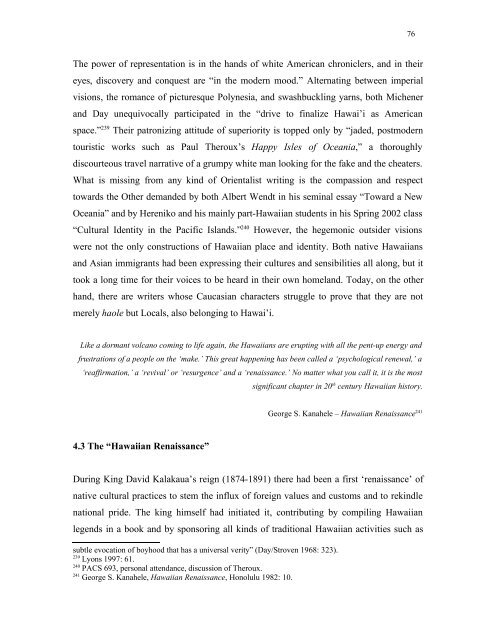A Paradise Lost - KOPS - Universität Konstanz
A Paradise Lost - KOPS - Universität Konstanz
A Paradise Lost - KOPS - Universität Konstanz
Create successful ePaper yourself
Turn your PDF publications into a flip-book with our unique Google optimized e-Paper software.
The power of representation is in the hands of white American chroniclers, and in their<br />
eyes, discovery and conquest are “in the modern mood.” Alternating between imperial<br />
visions, the romance of picturesque Polynesia, and swashbuckling yarns, both Michener<br />
and Day unequivocally participated in the “drive to finalize Hawai’i as American<br />
space.” 239 Their patronizing attitude of superiority is topped only by “jaded, postmodern<br />
touristic works such as Paul Theroux’s Happy Isles of Oceania,” a thoroughly<br />
discourteous travel narrative of a grumpy white man looking for the fake and the cheaters.<br />
What is missing from any kind of Orientalist writing is the compassion and respect<br />
towards the Other demanded by both Albert Wendt in his seminal essay “Toward a New<br />
Oceania” and by Hereniko and his mainly part-Hawaiian students in his Spring 2002 class<br />
“Cultural Identity in the Pacific Islands.” 240 However, the hegemonic outsider visions<br />
were not the only constructions of Hawaiian place and identity. Both native Hawaiians<br />
and Asian immigrants had been expressing their cultures and sensibilities all along, but it<br />
took a long time for their voices to be heard in their own homeland. Today, on the other<br />
hand, there are writers whose Caucasian characters struggle to prove that they are not<br />
merely haole but Locals, also belonging to Hawai’i.<br />
Like a dormant volcano coming to life again, the Hawaiians are erupting with all the pent-up energy and<br />
frustrations of a people on the ‘make.’ This great happening has been called a ‘psychological renewal,’ a<br />
‘reaffirmation,’ a ‘revival’ or ‘resurgence’ and a ‘renaissance.’ No matter what you call it, it is the most<br />
4.3 The “Hawaiian Renaissance”<br />
significant chapter in 20 th century Hawaiian history.<br />
George S. Kanahele – Hawaiian Renaissance 241<br />
During King David Kalakaua’s reign (1874-1891) there had been a first ‘renaissance’ of<br />
native cultural practices to stem the influx of foreign values and customs and to rekindle<br />
national pride. The king himself had initiated it, contributing by compiling Hawaiian<br />
legends in a book and by sponsoring all kinds of traditional Hawaiian activities such as<br />
subtle evocation of boyhood that has a universal verity” (Day/Stroven 1968: 323).<br />
239 Lyons 1997: 61.<br />
240 PACS 693, personal attendance, discussion of Theroux.<br />
241 George S. Kanahele, Hawaiian Renaissance, Honolulu 1982: 10.<br />
76

















